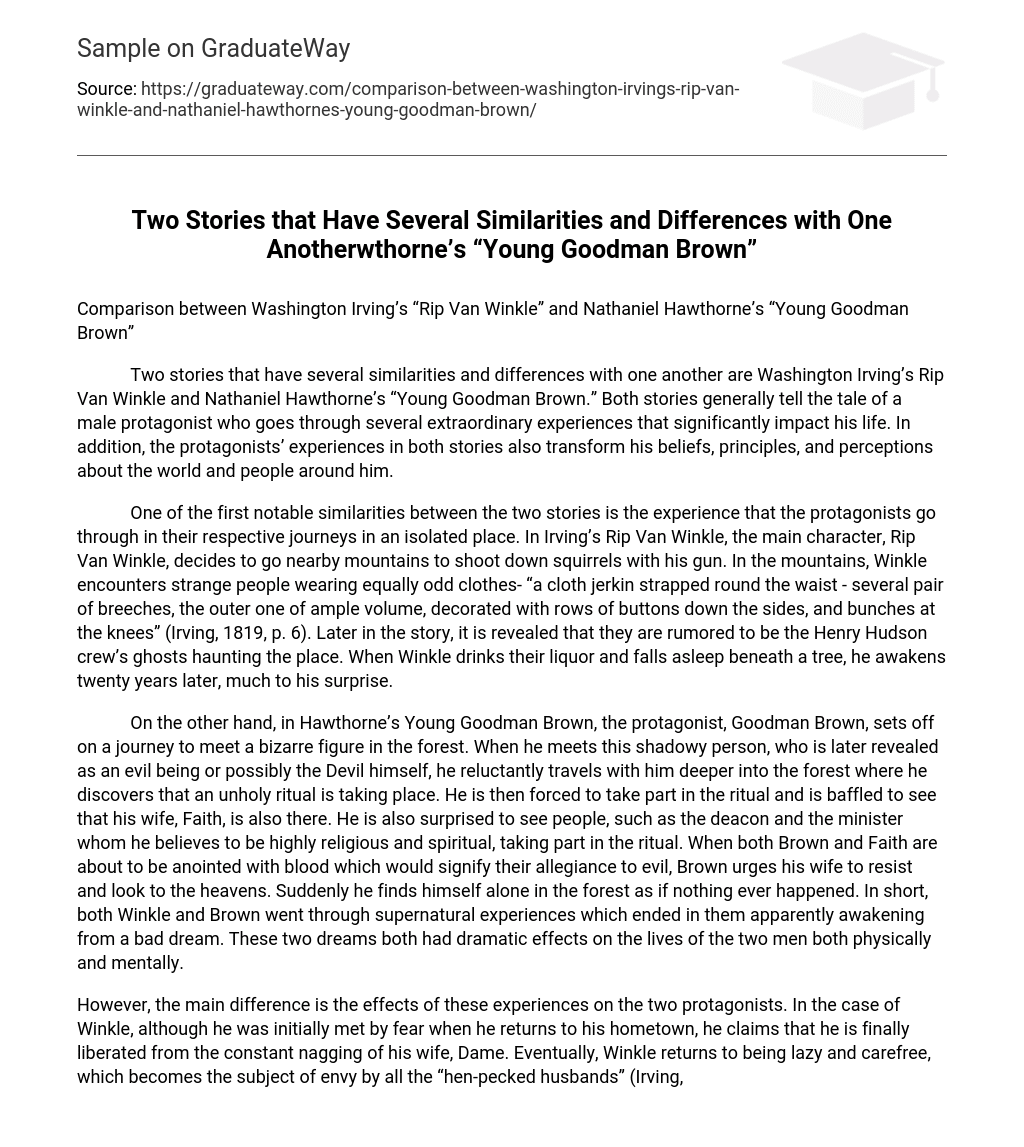Two stories that share several similarities and differences are Washington Irving’s “Rip Van Winkle” and Nathaniel Hawthorne’s “Young Goodman Brown.” Both tales follow a male protagonist who undergoes extraordinary experiences that significantly impact his life. Furthermore, the protagonists’ experiences in both stories transform their beliefs, principles, and perceptions about the world and people around them.
One of the first notable similarities between the two stories is the experience that the protagonists go through in their respective journeys in an isolated place. In Irving’s Rip Van Winkle,” the main character, Rip Van Winkle, decides to go to nearby mountains to shoot squirrels with his gun. While in the mountains, Winkle encounters strange people wearing equally odd clothes – “a cloth jerkin strapped round the waist – several pair of breeches, the outer one of ample volume, decorated with rows of buttons down the sides, and bunches at the knees” (Irving, 1819, p. 6). Later in the story, it is revealed that they are rumored to be ghosts haunting Henry Hudson’s crew. When Winkle drinks their liquor and falls asleep beneath a tree, he awakens twenty years later much to his surprise.
In Hawthorne’s Young Goodman Brown,” the protagonist, Goodman Brown, embarks on a journey to meet a mysterious figure in the forest. He reluctantly follows this shadowy person deeper into the woods where he discovers an unholy ritual taking place. Forced to participate in the ritual, he is shocked to see his wife, Faith, and other supposedly devout individuals such as the deacon and minister taking part as well. As they are about to be anointed with blood signifying their allegiance to evil, Brown urges his wife to resist and look towards heaven. Suddenly finding himself alone in the forest as if nothing had happened.
Both Winkle and Brown experienced supernatural events that ended with them seemingly waking up from a bad dream. These dreams had dramatic effects on both men physically and mentally.
However, the main difference between the two protagonists is the effect of their experiences. In Winkle’s case, he initially feels fear upon returning to his hometown but claims that he is finally liberated from his wife Dame’s constant nagging. Eventually, Winkle returns to his lazy and carefree ways, which makes him the envy of all hen-pecked husbands” (Irving, 1819, p. 14). On the other hand, Brown’s experience in the forest transforms him into a highly cynical man who is wary of everyone around him – including his wife Faith. He is unsure if the evil ritual he witnessed in the forest was real or not but remains convinced that every person he saw there – including Faith – has suspicious and wicked intentions.
Another notable difference between the two stories is the protagonists’ relationships with their respective wives. In Rip Van Winkle, it is vividly illustrated how Winkle dislikes his wife, Dame, for nagging him about being too lazy to take care of his family. He basically prefers not to see her on most days as he would have to endure her harsh words and criticisms.
On the other hand, in Young Goodman Brown, it is shown that Brown loves his wife more than anything else in the world. After leaving Faith to travel to the forest, he says “Well, she’s a blessed angel on earth; and after this one night I’ll cling to her skirts and follow her to heaven” (Hawthorne, 1835, p. 1). Moreover, when Faith was about to be anointed with blood that would seal her allegiance to the evil convention, Brown tried his best to convince his wife not to give in and hold on to her faith which shows that he truly cared for his wife unlike Winkle.
References
Hawthorne, N. (1835). Young Goodman Brown.
Washington Irving wrote Rip Van Winkle” in 1819.





